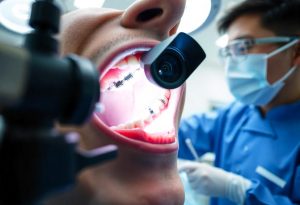How Intraoral Cameras Are Transforming Dental Care in Australia

Ever wished you could see what your dentist sees during your check-up? Now you can, thanks to a clever piece of technology called an intraoral camera. This small, but powerful tool is revolutionising dental care in Australia, offering a range of benefits for patients and dentists alike.
This blog post takes a closer look at intraoral cameras, exploring how they work, their many uses in dentistry, and why they’re becoming an essential part of modern dental practices.
What is an Intraoral Camera and How Does It Benefit Me?
An intraoral camera is a small, wand-like device that your dentist uses to take pictures inside your mouth. It’s about the size of a pen, with a built-in light and a tiny camera lens. The camera captures real-time images and displays them on a screen, allowing you to see exactly what your dentist sees.
Benefits for Patients:
- Clearer Communication: No more struggling to understand technical terms or descriptions. You can actually see the problem areas and understand why your dentist is recommending a particular treatment.
- Increased Understanding: Visualising your dental health can help you make informed decisions about your treatment options.
- Reduced Anxiety: Seeing what’s happening in your mouth can alleviate anxiety and fear, making your dental visits more comfortable.
- Improved Oral Health: By understanding your dental condition better, you’ll be more motivated to take good care of your teeth and gums.

How Intraoral Cameras Help Dentists Detect Cavities and Other Problems
Intraoral cameras are valuable diagnostic tools that help dentists identify a range of dental problems, including:
- Cavities: The camera can reveal hidden cavities, even in hard-to-reach areas.
- Cracks and Fractures: It can detect tiny cracks or fractures in your teeth that might be invisible to the naked eye.
- Gum Disease: The camera can help assess the health of your gums, identifying signs of gum disease like inflammation and recession.
- Worn Dental Work: It can show the condition of existing fillings, crowns, and other dental work, helping your dentist determine if they need to be replaced.
The Role of Intraoral Cameras in Modern Dentistry: Beyond Diagnosis
While diagnosis is a key function, intraoral cameras are used for much more:
-
Patient Education: The camera is a powerful educational tool. Your dentist can use it to show you exactly what’s happening in your mouth and explain your treatment options in a clear and understandable way. This can help you feel more involved in your dental care and make informed decisions.
-
Treatment Planning: Intraoral cameras play a vital role in treatment planning, especially for complex procedures like orthodontics or restorative dentistry. The images can help your dentist develop a precise treatment plan tailored to your specific needs.
-
Monitoring Progress: The camera can be used to track the progress of your treatment over time. This allows you to see the improvements in your oral health and stay motivated with your dental care routine.
-
Record Keeping and Insurance: The images captured by the intraoral camera become part of your dental records, providing a visual history of your oral health. These images can also be used for insurance purposes to support claims for dental treatment.
Why Intraoral Cameras Are Becoming Essential in Australian Dental Practices
Intraoral cameras offer numerous advantages for both patients and dentists:
- Improved Communication: They enhance communication between the dentist and patient, leading to better understanding and trust.
- Early Detection: They enable early detection of dental problems, allowing for timely treatment and preventing more serious issues.
- Increased Accuracy: They provide a clear and magnified view of the mouth, improving diagnostic accuracy and treatment planning.
- Enhanced Patient Comfort: The small size and comfortable design of the camera make dental exams more comfortable for patients.
- Greater Efficiency: Intraoral cameras streamline dental procedures, saving time and improving efficiency.

The Future of Intraoral Cameras in Dentistry
As technology continues to advance, we can expect even more exciting developments in the field of intraoral cameras:
- Higher Resolution Images: Future cameras will likely offer even higher resolution images, providing even greater detail and clarity.
- 3D Imaging: Some intraoral cameras already incorporate 3D imaging capabilities, allowing for more comprehensive and accurate assessments.
- Artificial Intelligence (AI): AI is being integrated into dental technology, with the potential to assist in diagnosis and treatment planning using intraoral camera images.
- Teledentistry: Intraoral cameras are playing a growing role in teledentistry, allowing dentists to provide remote consultations and diagnoses.
Conclusion
Intraoral cameras are transforming the way dentists provide care in Australia. By offering a clearer view, improved communication, and enhanced patient comfort, these innovative tools are helping to create a more positive and effective dental experience for everyone. So, the next time you visit your dentist, don’t be surprised if you see your smile in a whole new light!
References:
https://www.healthline.com/health/gingivitis
https://www.webmd.com/oral-health/receding_gums_causes-treatments
